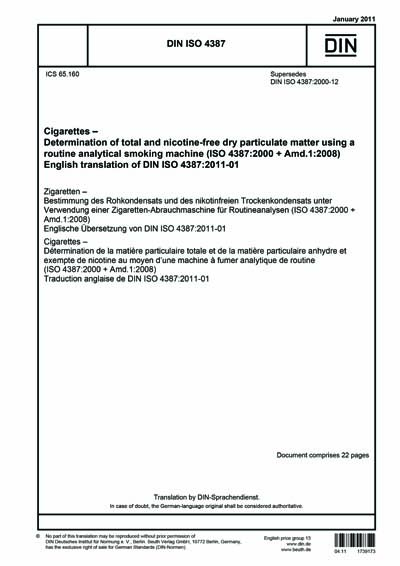Historical
DIN ISO 4387:2011
Cigarettes - Determination of total and nicotine-free dry particulate matter using a routine analytical smoking machine (ISO 4387:2000 + Amd.1:2008)
This standard specifies methods for the determination of total particulate matter and for subsequent determination of nicotine-free dry particulate matter present in the smoke from cigarettes generated and collected using a routine analytical smoking machine.*The International Standard ISO 4387 specifies a method for the determination of total particulate matter and for the subsequent determination of nicotine-free dry particulate matter present in the smoke from cigarettes generated and collected using a routine analytical smoking machine. Cigarettes are manufactured to close tolerances using strict quality control procedures. However, all the constituents involved in the manufacture are derived from natural products (tobacco, cigarette paper, tipping, etcetera) and this results in a final product which is intrinsically variable. The complexity does not finish here because the cigarette is converted during smoking to cigarette smoke. Cigarette smoke is a complex mixture consisting of many individual chemical constituents which exist as gases, vapours and condensed aerosol particles. Additionally, various ageing processes, together with diffusional and intersolubility effects, start occurring immediately after the formation of the smoke which further complicate its composition. The quantitative measurement of nicotine-free dry particulate matter (NFDPM, sometime referred to as "tar") is, therefore, dependent on its arbitrary definition. From the time that scientists have attempted to determine a value for NFDPM, many different methods have been used. However, experience has shown some procedures to be more reliable. With these factors in mind, during 1988 and 1989, collaborative studies by Task Forces composed of members of the Cooperation Centre for Scientific Research Relative to Tobacco (CORESTA) Smoke and Technology groups have been made on the repeatability and reproducibility of the determination of total and dry particulate matter from cigarettes. The studies show that improvements in repeatability and reproducibility result when some restrictions are placed on the wide variety of methods and practices permitted by existing standard methods. Thus, this International Standard, and the others which together form a complete set for the sampling, conditioning and determination of nicotine, water and particulate matter from cigarettes, have been produced after much cooperation and collaborative experimentation by many laboratories in many countries. CORESTA first published a standard for the machine smoking of cigarettes in 1968. Since that time many improvements in equipment as well as in procedure have been suggested. This International Standard incorporates these improvements and consequently represents thestate of the art on this subject. It provides one set of procedures accepted as reference methods. This method is a machine method and allows cigarettes to be smoked using a strictly controlled set of parameters. Thus, it enables the NFDPM and nicotine from cigarettes, when smoked by this procedure, to be compared and ranked on the basis of machine yield. No machine smoking regime can represent all human smoking behaviours: - it is recommended that cigarettes also be tested under conditions of a different intensity of machine smoking than those specified in this International Standard; - For design and regulatory purposes, machine smoking is useful to receive information about components of cigarette smoke. The displayed data of machine measurements can, however, lead to misunderstandings among smokers about differences in exposure and risk across brands; - data from machine smoking measurements may be used to contribute to risk evaluation, they are not intended to be nor are they valid as measures of human exposure or risks. The application of ISO standards for testing products is abusive if measurement results of different products are communicated as differences in exposure or risk. After revision of the second edition, the third edition of International Standard ISO 4387 was published in 2000. In 2008 an amendment was published in which it was explained that no single machine smoking regime can represent all human smoking behaviours. Working Committee NA 057-04-01 AA "Tabak und Tabakerzeugnisse" ("Tobacco and tobacco products") of the Food and Agricultural Products Standards Committee (NAL) at DIN decided to supplement DIN ISO 4387, which was published in 2000, by the addition of the amendment to ISO 4387 published in 2008. The Working Committee made its decision particularly in terms of the necessary harmonization of international and national standards in the field of smoke analysis.
Content Provider
Deutsches Institut für Normung [din]






